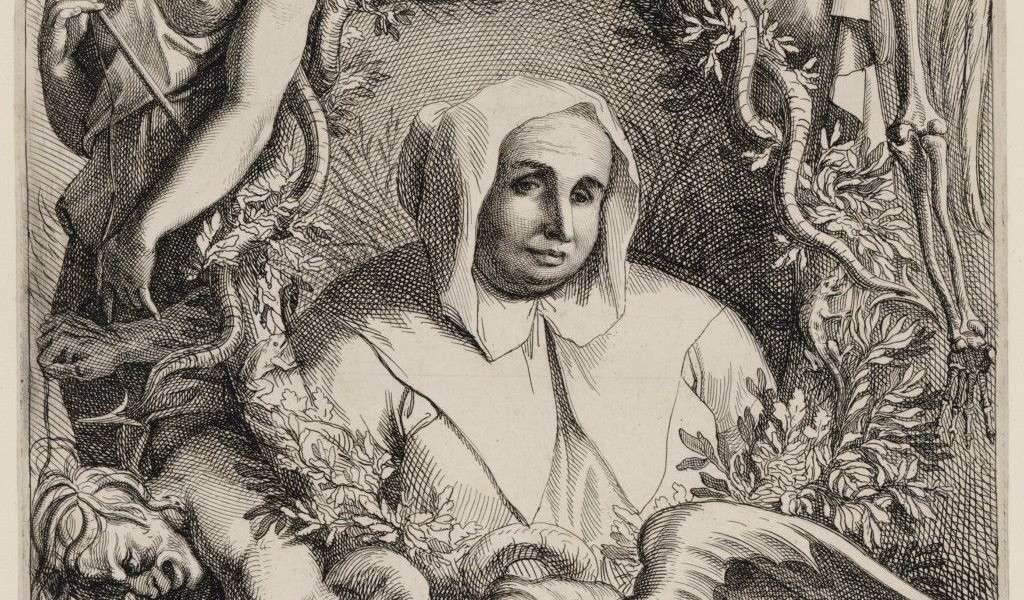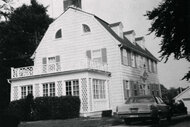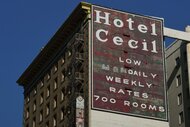Create a free profile to get unlimited access to exclusive videos, sweepstakes, and more!
La Voisin, France's murderous fortune teller

At 40 years old, Catherine Montvoisin found herself standing in a darkened room, draped in light-snuffing curtains, lit only by torches as a group of robed, faceless men sentenced her to death by fire.
It was an odd ending to the life of someone whose outward appearance seemed relatively normal for 17th-century times. Catherine was the wife of a jeweler and silk merchant. She lived comfortably in the bustling Villeneuve Sur Gravois, a district in the heart of Parisian society. She was a mother, an entrepreneur, a philanthropist, a lover of the arts.
But she was also a witch, one who nearly toppled the French aristocracy and almost succeeded in killing a king.
You won't find much about Catherine's early life in any history book. Born Catherine Deshayes in the year 1640, it was thought she had a hard upbringing. Poverty was no doubt involved. The term street urchin might be befitting. How else would one explain a 9-year-old girl who had mastered selling fortunes to nobles for a few livres?
She married a merchant named Antoine Montvoisin when she was 20 and quickly discovered her new husband's incompetence and unreliability. His business was failing, he was in massive debt, and Catherine refused to return to a life on the streets. So she did what any enterprising young woman with a knack for palm reading and a basic understanding of the dark arts did in those days: She became a mistress of poison.
Not at first, of course. No, Catherine began her studies in witchcraft by catering to the elite circles of the French aristocracy. She practiced chiromancy and face-reading, telling depressed, unsatisfied housewives how to better their marriages (or escape them) by simply reading the lines on their hands and faces. She was an herbalist, so sometimes the occasional remedy for aches and pains came into play, as did her services as a midwife — she had learned how to give women abortions, a procedure that was all the rage in those days when strict Catholicism and the desire for debauchery just didn't mix.
The Church disapproved — strong-willed women with a touch of black magic about them terrified those red-robed hypocrites back then — but Catherine was clever and uncompromising. She convinced the vicars and professors of theology at Sorbonne university who balked at her profession that any divination skills she possessed were bestowed upon her by God. She simply used psychology and her faith to help people in need.
They bought it, and Catherine's business, now seemingly endorsed by the Church, began to flourish.
Of course, being the shrewd businesswoman she was, Catherine started to notice a trend among her clients. Most of them, if not all, wanted something from the men in their lives. Some wanted men to become their husbands, some wanted their husbands dead, some wanted to inherit their familial fortune, etc. So Catherine started crafting potions to help those desires along. She'd grind the bones of toads with Spanish fly, human blood, and iron shavings to help some of the noblest women in Parisian society bewitch lovers and would-be husbands.
But it wasn't the love spells or crystal ball readings that led Catherine, who became known as La Voisin, to the stake … it was murder and Black Masses and, yes, poison.
Once her reputation began to grow, La Voisin decided to capitalize on the desperation and deep pockets of her clientele. One of her most expensive services would become a damning charge in her eventual trial. La Voisin employed the help of priests – some of whom were her lovers, others who had debts they needed to settle in order to keep their own mistresses comfortable – to perform Satanic rituals in the catacombs underneath her home. These blasphemous Black Masses were dark inversions of a traditional Catholic ritual in which a naked woman would act as an altar, lying down while holding black candles in each hand with a chalice resting on her stomach. A priest would perform Satanic rites over her body before spilling the blood of a newborn baby into the cup as the woman prayed to the dark lord.
Whether the baby needed to be alive or not, we're not sure, but procuring a child for the services wasn't difficult for La Voisin. She had opened a home for unwed mothers years prior, helping women with unwanted pregnancies procure abortions or helping lower class ladies get rid of their babies after childbirth. She didn't charge her peasant clientele for these services, instead billing aristocratic women who came to her for help extra to pay for her charity. These were women who couldn't afford the scandal of a child out of wedlock, or women who simply couldn't afford to raise a child on the unforgiving streets of Paris in the 17th century. La Voisin might have told them she'd find homes for the children, or she might have told them nothing at all. Either way, she had a constant supply of sacrifices thanks to her philanthropy and to the unforgiving standards of Catholicism at the time.
And sure, Black Masses, human sacrifices, the killing of infants — they all sound bad. But it's the poisonings, some of which La Voisin wasn't even directly involved in, that really got our DIY high priestess in trouble.
The L'affaire des poisons ("Affair of the Poisons") was a scandal that rocked French nobility in the 17th century.
It began with the trial of Madame de Brinvilliers who was accused of working with her lover to murder her father and brothers so that she could inherit his estate. The Sun King himself, King Louis XIV, became terrified he might also become a victim of poisoning (he began having servants taste-test his meals) and so he gave the chief of the Paris police permission to conduct what amounted to a witch hunt following the arrest of Magdelaine de La Grange, another fortune teller in Paris with ties to Brinvilliers' case.
It was La Grange who pointed the finger at another woman, Marie Bosse, a famed French poisoner who was one member of an elaborate network of fortune-tellers and alchemists and divination masters that La Voisin had built over the years. (Catherine couldn't handle the mountain of requests from the ladies of court so she'd contract work out to other women with special talents in the dark arts.) Bosse and La Voisin were rivals — Catherine enjoyed higher-paying clientele because, among other things, she displayed a lavish lifestyle and spent money on things like velvet robes trimmed in gold to convince educated and uneducated women alike that she was, in fact, the "real deal." Bosse was better at poisoning than La Voisin was though, and their grudge-match was the only fuel she needed to implicate Catherine in the Affair of the Poisons.
So, Catherine was arrested, though probably not tortured, which is what you'd expect for a woman accused of witchcraft at the time. No, the Chief of Police knew La Voisin to be a woman of certain indulgences — she often had multiple lovers and a serious love of wine – so he kept her intoxicated while jailed, probing her for details on who she served and what those services entailed while keeping her, well, drunk.
And the truth eventually came out.
Not only did La Voisin nurse some of the darkest fantasies of the city's elite, but she also came very close to poising the king himself. Her most high-profile client was Madame Montespan, the official mistress of King Louis XIV who, it's believed, first sought La Voisin's services in procuring love potions to make the king obsess over her instead of his formal mistress at the time who was also pregnant with his child. Whatever La Voisin did for her worked because Madame Montespan was the maîtresse-en-titre to the king for over a decade. But, his eye began to stray to the Duchess of Fontanges, forcing Montespan to ask more of La Voisin, including Black Mass rituals and, some believe, a powder to poison either the king's new lover — who died shortly after their romance began — or the king himself.
With this new bit of information revealed, La Voisin was destined to burn at the stake for witchcraft, her death to set an example for the women of the court and the necromancers and fortune-tellers doing business in Paris. It's believed she helped poison over 1,000 people and some speculate she killed over 2,500 infants in her ceremonies. She went to her death in early 1680 after the Chambre Ardente — the "fiery court" — found her guilty and worthy of one of the harshest punishments the court could deal out. But she didn't go quietly. Some say she begged for mercy from the crowd, some say she shouted her innocence, and others say she cursed the families of each of the men responsible for her verdict.
In total, over 300 people were arrested in the investigation with 36, including La Voisin, being executed for their crimes. Most of the French nobility, including Montespan, escaped punishment thanks to King Louis XIV, who worried if people learned the truth — that his court was teeming with liars, murderers, and practitioners of witchcraft — the peasant class would rebel or worse, England would use the scandal as a reason to invade.
And so, for a time, Catherine Montvoisin — a murderer, fortune teller, street rat, entrepreneur, high priestess, prisoner, and yes, a witch — was perhaps even more powerful than the Sun King himself.


























